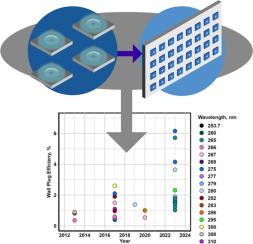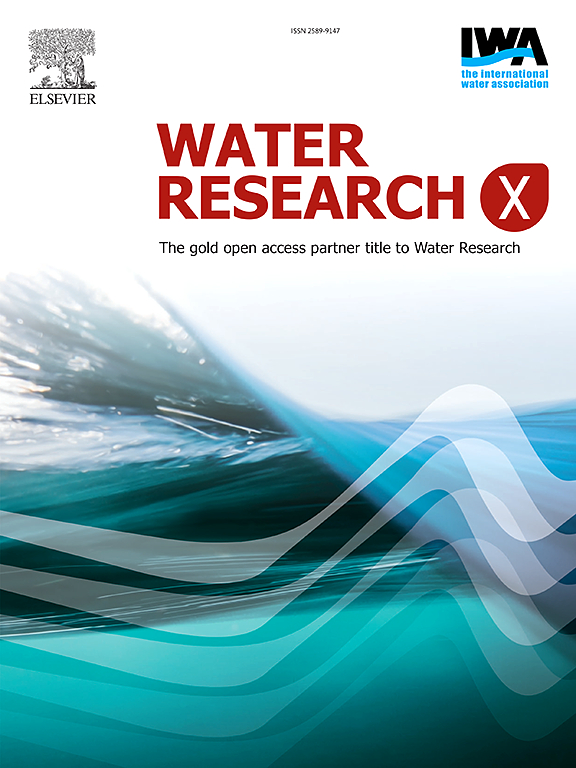紫外线发光二极管作为一种水消毒技术的重要评述
IF 8.2
2区 环境科学与生态学
Q1 ENGINEERING, ENVIRONMENTAL
引用次数: 0
摘要
紫外线发光二极管 (LED) 消毒技术在过去十年中取得了长足进步,为使用点、工业以及现在的全面水处理应用拓展了设计空间。本文献综述利用总光功率、价格和壁插效率等关键特性,研究了紫外线 LED 技术从 2007 年到 2023 年的发展情况。综述发现,光功率在不断增加,而每瓦价格却在不断下降;不过,在过去十年中,壁插能量(WPE)却在缓慢提高。这些因素决定了许多紫外发光二极管应用的可行性,并确定了这些技术的现状。我们对低压、中压和紫外 LED 光源的灭活率常数进行了分析,全面了解了当前紫外 LED 技术与传统技术的比较情况。比较发现,紫外线 LED 与传统紫外线技术在消毒细菌和病毒方面的性能相当。此外,本综述还探讨了紫外 LED 直通式反应器在台式、中试和全规模试验中的减排等效通量比较,发现 LED 处理在处理增大的流速方面越来越有效,并已被证明可在全规模试验中发挥作用。不过,紫外线 LED 还需要进一步研究不同波长对水基质的影响,以及每种可用 LED 波长对消毒的影响。总之,这项研究对紫外线消毒技术进行了广泛的评估,为有兴趣了解这项快速发展的技术的人提供了最新的参考文件。本文章由计算机程序翻译,如有差异,请以英文原文为准。

A critical review of ultra-violet light emitting diodes as a one water disinfection technology
UV light emitting diode (LED) disinfection technologies have advanced over the last decade and expanded the design space for applications in point of use, industrial, and now full-scale water treatment. This literature review examines the progression of UV LED technologies from 2007 to 2023 using key features such as total optical power, price, and wall-plug efficiency. The review found that optical power is increasing while the price per Watt is decreasing; however, the wall plug energy (WPE) is slowly improving over the last decade. These factors govern the feasibility of many UV LEDs applications and establish the current state of the art for these technologies. An analysis of inactivation rate constants for low-pressure, medium-pressure, and UV LED sources was undertaken and provides a comprehensive view of how current UV LED technologies compare to traditional technologies. This comparison found that UV LEDs perform comparably vs conventional UV technologies when disinfecting bacteria and viruses. Furthermore, comparison of reported reduction equivalent fluences for UV LED flow-through reactors at the bench-, pilot-, and full-scale were explored in this review, and it was found that LED treatment is becoming more effective at handling increased flowrates and has been proven to work at full-scale. UV LEDs do however require additional research into the impacts of water matrices at different wavelengths and the impact that each available LED wavelength has on disinfection. Overall, this work provides a broad assessment of UV disinfection technologies and serves as a state-of-the-art reference document for those who are interested in understanding this rapidly developing technology.
求助全文
通过发布文献求助,成功后即可免费获取论文全文。
去求助
来源期刊

Water Research X
Environmental Science-Water Science and Technology
CiteScore
12.30
自引率
1.30%
发文量
19
期刊介绍:
Water Research X is a sister journal of Water Research, which follows a Gold Open Access model. It focuses on publishing concise, letter-style research papers, visionary perspectives and editorials, as well as mini-reviews on emerging topics. The Journal invites contributions from researchers worldwide on various aspects of the science and technology related to the human impact on the water cycle, water quality, and its global management.
 求助内容:
求助内容: 应助结果提醒方式:
应助结果提醒方式:


